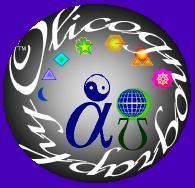How to Operate this Web Site (4/7)
Left (green) column
Left columns, users byside of system's approach and right column about themselves.
User
You? defining the kind of user of present system (actually do not hurry: we are not "freely enchained behind our screen" that is why this website looks so "unprofessional"). For the future mind the sort of public:
- "popular": humane practical field level, deserving not too reduced logical frameworks for practical democratic field work. At first use tools as you feel and report, the system does not bring much.
- "method": sort of documents and tools for providers, for the software and knowledge development of the system. Actually we would appreciate collaboration, yet not enough advanced, to accept blindy anyone.
- "advanced": support for advanced users. In the concept of visual frameworks mind that on one side they should suggest less complicated frameworks but enough rich for popular level and, on the other side, that could inspire the development of interactive interfaces.
Use?
- "explore": simple users of the system (common public audience purpose) that is willing to find tools and orienting information.
- "document": if you have visual documents to propose or want to obtain... in a systematic process as a technicien or like field provider with feedbacks, experiences, applied values and programs that did well (practical field techniciens audience),
- "proposal": when you will have some system - software suggestions or packages or systemic links between documents (technical providers audience, specialists)
Perspective?
- "qualitative": mainly visual supports, remind this web site prefers inspiring synthesis for options, choice and intermediation; between essential work and knowledge. Kind of specialized and detailed knowledge. Non essential social utility, too high tradable one should stay in hands of their utility makers, as well as easy to fill dictionnary. Present wiebsite is a minimalist conceptual structured thesaurus and practical encylopedia for democratic fields.
- "quantitative": when frameworks will develop sheet(s) of calculus (in the same framework or in addition) should appear,
- "synthesis": if economic - financial formulation could be developed, once real technical anchor there.
Usage?
- "function": to detect your applied field purpose; like making existing essential structures current works or care, for which you need criteria. Considering for exemple environment (no need to focus on what you should build or sort of high investments you should make if this is out possibilities),
- "structure": as before, in constrast what you need as structures, main investments you can pretend,
- "issue": if you have consistent information and already functional frameworks.
Concern
- "object": perhaps when system will be enough flexible and interactive material to help you in "assisted-design-logical-democratic-frameworks",
- "operation": where to design your operations like for establishing a social algebra and other meaningful calculus,
- "calculate": if it could happen one day, possible to provide a system of calculus of your own.
There is indeed some redundancy in previous subsystems of categories this to feed some debate on the sort of contain of these categories, in a few years or within many months
Graph Start
We have mentioned that intuitivelly the number of nodes or key concepts of graph can inspire purpose and sorts of properties which can come from scientific issues (nature is also economics but not as determinist as humans want) or as our will. Anyhow and not so subjectivelly: it is obvious that we are not perfectly infinitelly and only regularly only managed by ourself. We can make formal agreements for a while in a social algebra and, this may also be reflected in our cognitive processes. So our modular graphs seek in "multiple but not too many layers of concepts development", to match scientific coherence and let some flexibility and consistency to our commitments (and hope so not too far away from common humane values). So let see if these hypothesis have ground.
Users can point directly to a structure of graph they feels appropriate or detail the properties they expects and we will test correlations and patterns and both will feedback each others. Anyhow users will be served with information and supports (and appreciate if they have been useful).
Our sort of philosophical management of complexities let you almost free from dogmatism. The questions on complexity periodically and increasingly sooner reappear after new failures of deterministic managment. The core of first layer of contrast provides, in our system, sort of tools of functional perspective. And if you are not convince by our disposal there are also the technics to put that in sentencious lists of activities: delay prefield practical execution is for respecting field reality. It is more easy to brainstorm somehow freely. It is easier to established procedures as sequences that way rather than trying to remember exact sequence with competing concepts.
Core n°
- "1 to 3": as for unique (avoid), dual (care for all dark or all right), 3 prefers doubt uncertainty and open mind, at least for starting an investigation or a design.
- "4 to 6": if you balance, catch, position, twice dual, judge, integrate, relate or mix, separate, fusion, merge, inmerse, and so on.
- "7 to 9": if you project, get on, divide, coalition, while keep an eye on structure and simplifications to previous general, but not too short solutions.
- "10 or more": if you universe, wholesome, include any, may consider complex systems start.
Get to the method package, this is explained with more details
Half complex graphs
No categories there. See that olicognograph develops with layers of few arguments, to stay somehow calculable and reasonably manageable and is managed as a complex unitary system . As a result, to have such starting structure a bit more complicated is a matter of case by case and which graphic superstructure can picture "cybernetically" something as an effective model.
